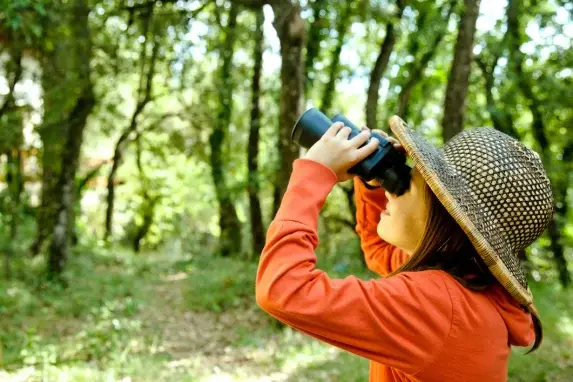
Posted June 1st 2020
Take Your Kids Bird Watching This Summer!

Posted June 1st 2020
Take Your Kids Birdwatching This Summer!
We love to watch our local birds (and protect them from window collisions!) all year long. But there’s something about the return of our migratory species, and the abundance of sunshine, that makes summer birdwatching especially exciting. Even if you’re awakened by early morning birdsong before the sound of your alarm, the sights and sounds of returning birds bring undeniable joy to our daily lives.
So, if you’re hoping to get yourself and your little ones outdoors this summer, there’s no better activity than some birdwatching. Birdwatching is an educational and stimulating activity for children and adults alike, and learning about local species will deepen your connection with nature. The team at Feather Friendly® has compiled numerous tips on common summer species, and a few ideas on how to get your kids involved, so that you learn about the birds you love, and protect them too, all summer long. Birdwatching can foster your family’s interest in protecting birds against window collisions and get your child involved in future conservation efforts!
Finding Local Species in Your Area
Some individuals won’t have to look very hard to enjoy the majesty of a bird in flight. In fact, if you have native plants, adequate food sources, nesting areas, and your yard is relatively safe from predators, you may be able to bird watch from the comfort of your own home. Even if you don’t have a particularly well-developed yard or live in an urban area where greenery is scarce, there are still many areas where you can admire your feathered friends from afar.
We’ve collected the data of three common North American species, using All About Birds’ Bird Guide to help you on your birding journey.
SPECIES
American Goldfinch
Eastern Bluebird
Blue Jay
LOCATION & HABITAT
- Species: American Finch
- Fields, floodplains, and a variety of spaces that are abundant in thistles and weedy plants.
- Cultivated areas, including roadsides, orchards, and backyards are also common.
- Species: Easter Bluebird
- Meadows and open fields.
- Eastern Bluebirds will nest in hollowed out trees or boxes, and they are commonly found along roads, golf courses, and telephone wires during summer months.
- Species: Blue Jay
- Blue Jays favour forest edges, or anywhere that acorns are abundant.
- Common across Canada and the United States, Blue Jays are found near oaks, in forests, woodlots, towns, cities, parks.
BEHAVIOUR
- Species: American Finch
- A very entertaining and energetic species, American Goldfinches are known for their frequent acrobatics and their active backyard feeding.
- They will call out as they fly, which can attract attention to them.
- Species: Eastern Bluebird
- Eastern Bluebirds prefer high perches to look for potential prey.
- Because they feed on insects during the summer, Eastern Bluebirds are not as common as backyard feeders.
- Species: Blue Jay
- Blue Jays are popular at backyard feeders, and their loud, distinct calls make them easy to identify.
- They eat a variety of sunflower seeds, acorns, and peanuts, and will use their feet to assist them with eating!
DESCRIPTION
American GoldfinchesAmerican Goldfinches are bright yellow, black, and white; females are duller in colour than males.
Eastern BluebirdsEastern Bluebirds are a striking royal blue with a red brown breast. Females are slightly greyer with blue-tipped wings.
Blue JaysBlue Jays have a distinct black, white, and blue pattern. The Blue Jay’s crest, bright white belly, and long tail make it easy to identify.
Have you spotted any of these common species in your yard or neighbourhood yet?
One way to look out for local species is to familiarize yourself with their calls and colouring. Knowing where birds tend to feed and how they sound can help you locate birds in densely wooded areas, or in habitats that are more unfamiliar to you. Some species, like the Eastern Bluebird, won’t appear at feeders and prefer to perch far above the ground, which makes them more difficult to spot. Of course, one of the simplest ways to find birds is to look outside your door; you may be surprised at the variety of species that live in your backyard. If you’re hoping to attract different species to your yard, planting native plants, setting out a birdfeeder, and keeping cats indoors are just a few ways you can make your yard bird-friendly.
How to Get Your Kids Outdoors with Birdwatching
According to Audubon, “Only about 10 percent of kids spend some time outside every day.” Shrinking rural spaces, new technology, and a host of other factors have effectively prevented kids from interacting with nature on a regular basis.
Although birding may not be your child’s first choice of activity, encouraging your children to form a respectful relationship with the environment, and letting them explore their surroundings, can help foster a genuine concern for protecting natural environments, and find joy in nature. Audubon contributor, Nicholas Lund, acknowledges that, while birding may not seem as appealing as playing a game, or a sport, parents can make a game out of birding by letting their child pick a spontaneous path, location on a map, or local conservation area. Parents can provide their child with a sense of freedom and fun by allowing their child to shape their own birding experience.
Make Your Birdwatching Adventure Eco-Friendly
Lund also recommends integrating binoculars, cameras, and birding guides to supplement their bird-watching experience. Viewing the same species of bird in a book, through binoculars, and then capturing a photo of it will make a memorable experience for children.
Use birdwatching as an opportunity to teach children about the role birds play in our ecosystem and how we can protect them through maintaining the environment with reusable items and setting boundaries. Let your kids come up with a list of items that are environmentally friendly:
- Binoculars
- Bird guide
- Camera
- Litter-free lunch
- Reusable bottles
Teach your children to take photos, stay on the path, maintain a safe distance while observing species, and leaving birds, birds’ nests, plants, and flowers where you found them. Instructing your children on how to treat nature will help them understand that nature should be protected and can be enjoyed from afar.
Kid-Friendly Can Be Bird-Friendly!
Don’t let your child’s interest in the environment stop at home! You can use your downtime in between birding to educate your child about the impact of window collisions. Show your kids how they can protect local birds by using bird deterrent window markers, and invite them to help you make your home bird-friendly. Order Feather Friendly® DIY tape today to make your windows bird-friendly, keep your backyard birds thriving, and to get your young birder outdoors!
Partners
We are honoured to form partnerships with organizations who demonstrate
an ongoing commitment to bird conservation.



